Receive our newsletter
Your e-mail address is only used to send you our newsletter and information about the activities of Strasbourg Europe. You can always use the unsubscribe link included in the newsletter.
First place to see: the Palace of Europe, which houses the Council of Europe. This building, an imposing edifice of 64000 m², inaugurated in 1977, was designed by the French architect Henry Bernard.
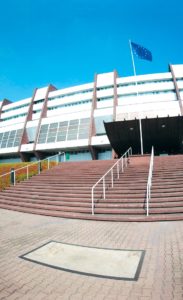 At the foot of the main stairway leading to the Palace of Europe, you can see at your feet the “Stone to the victims of hunger.” This slab of white marble, offered in 1987 by the non-governmental organization ATD Quart Monde, is dedicated to the suffering and the courage of the victims of misery.
At the foot of the main stairway leading to the Palace of Europe, you can see at your feet the “Stone to the victims of hunger.” This slab of white marble, offered in 1987 by the non-governmental organization ATD Quart Monde, is dedicated to the suffering and the courage of the victims of misery.
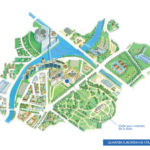
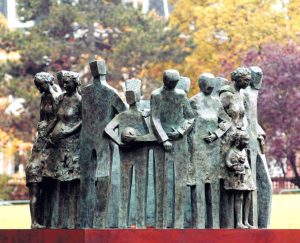 To the left of the lawn, you can appreciate a work of the sculptor Mariano González Beltrán entitled “Human Rights“. It consists of many bronze statues making a circle of men and women. The work, a gift from Spain, symbolises a society living in harmony with human rights, like the work of the Council of Europe.
To the left of the lawn, you can appreciate a work of the sculptor Mariano González Beltrán entitled “Human Rights“. It consists of many bronze statues making a circle of men and women. The work, a gift from Spain, symbolises a society living in harmony with human rights, like the work of the Council of Europe.
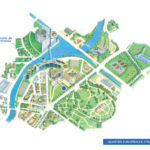
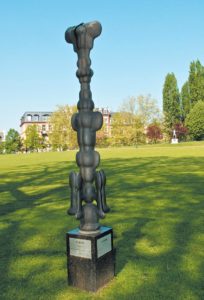 Nearby this work, you can contemplate another sculpture of electrolyzed copper measuring 2.44 meters, which represents, according to its Austrian creator Rudolf Kedl, “a female figure rising out of the flames.” This work, entitled “Europe,” was a gift from Austria to the Council of Europe in 1985.
Nearby this work, you can contemplate another sculpture of electrolyzed copper measuring 2.44 meters, which represents, according to its Austrian creator Rudolf Kedl, “a female figure rising out of the flames.” This work, entitled “Europe,” was a gift from Austria to the Council of Europe in 1985.
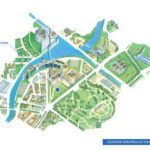
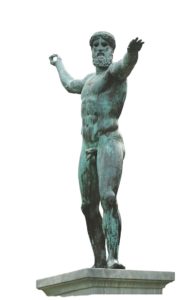 At the end of the lawn you can admire a reproduction of a bronze statue, entitled “Poséidon d’Artémision,” which was offered by Greece in 1998 and represents Poseidon, the god of the sea. The original was recovered in 1928 at the cape of Artemision, north of the island of Euboea in the Aegean Sea. The work is attributed to the Athenian sculptor Calamis and dated in the year 450 B.C. The original can be found at the National Archaelogical Museum of Athens.
At the end of the lawn you can admire a reproduction of a bronze statue, entitled “Poséidon d’Artémision,” which was offered by Greece in 1998 and represents Poseidon, the god of the sea. The original was recovered in 1928 at the cape of Artemision, north of the island of Euboea in the Aegean Sea. The work is attributed to the Athenian sculptor Calamis and dated in the year 450 B.C. The original can be found at the National Archaelogical Museum of Athens.
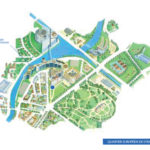
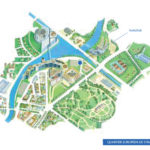
To continue your walk, travel along the building to the right until you arrive at a lawn around the restaurant of the Council of Europe, where two works can be found.
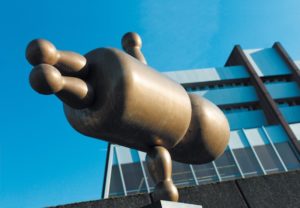 First, you can admire a majestic statue of bronze 2.79 meters high on a wooden base, created by the Croatian artist Vasko Lipovac. It was a gift from Croatia in October 2006, offered on the occaission of the tenth anniversary of the accession of Croatia to the Council of Europe. This work, entitled “Gymnast,” highlights the virtuosity of a gymnast who symbolises this perogative of the human race to break his chains and be free.
First, you can admire a majestic statue of bronze 2.79 meters high on a wooden base, created by the Croatian artist Vasko Lipovac. It was a gift from Croatia in October 2006, offered on the occaission of the tenth anniversary of the accession of Croatia to the Council of Europe. This work, entitled “Gymnast,” highlights the virtuosity of a gymnast who symbolises this perogative of the human race to break his chains and be free.Next stop: Quai Ernest Bevin, before the building housing the European Court of Human Rights. This building, inaugurated in 1995, was designed by the British architect Richard Rogers.
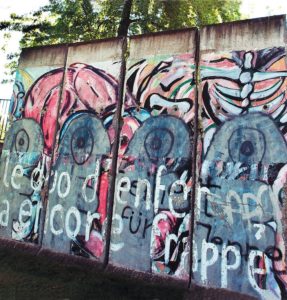 On the lawn adjacent to the main entry of the Palace of the Rights of Man you can contemplate on your left a four-part panel (3.60X4m) of the Berlin Wall, offered by Germany in 1989. The pannels presented were chosen for their symbolic value. You can see the word “Freiheit” (freedom) under the sentence in French.
On the lawn adjacent to the main entry of the Palace of the Rights of Man you can contemplate on your left a four-part panel (3.60X4m) of the Berlin Wall, offered by Germany in 1989. The pannels presented were chosen for their symbolic value. You can see the word “Freiheit” (freedom) under the sentence in French.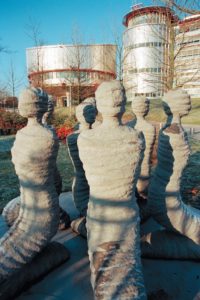 To the right of the main entrance, approach the “Seven Petrified.” This gift from Switzerland is a collection of statues created by Carl Bucher in 1995. This work expresses the traumatising experiences of physical and psychological violence. It also symbolises the values of the Council of Europe: pluralist democracy, rule of law and the rights of man.
To the right of the main entrance, approach the “Seven Petrified.” This gift from Switzerland is a collection of statues created by Carl Bucher in 1995. This work expresses the traumatising experiences of physical and psychological violence. It also symbolises the values of the Council of Europe: pluralist democracy, rule of law and the rights of man.
The next place to see: the Louise Weiss building, housing the European Parliament. This building, conceived by the group of French architects Architecture Studio Europe and inaugurated in 1999, carries the name of Louise Weiss in honour of the female politician and writer who dedicated herself to the defence of the European idea as well as the struggle for women’s rights.
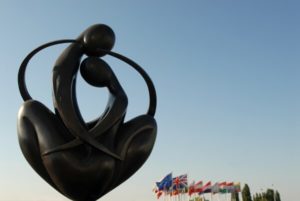 Upon arriving at the Louise Weiss building of the European Parliament, you can admire a sculpture by the French artist Ludmila Tcherina (real name Monika Tchemerzine) entitled “Europe at Heart.” You can see two figures mingling to form a heart with their legs to symbolise the city which has become a symbol of the reconciliation and the heart of the european continent. It is a sculpture officially chosen by the European Community to symbolise the united Europe. It was first installed in front of the old buildings of the European Parliament in 1994. On December 13, 2000, Nicole Fontaine, then President of the European Parliament, finally inaugurated the statue on the court of the new chambers of the Parliament.
Upon arriving at the Louise Weiss building of the European Parliament, you can admire a sculpture by the French artist Ludmila Tcherina (real name Monika Tchemerzine) entitled “Europe at Heart.” You can see two figures mingling to form a heart with their legs to symbolise the city which has become a symbol of the reconciliation and the heart of the european continent. It is a sculpture officially chosen by the European Community to symbolise the united Europe. It was first installed in front of the old buildings of the European Parliament in 1994. On December 13, 2000, Nicole Fontaine, then President of the European Parliament, finally inaugurated the statue on the court of the new chambers of the Parliament.On the other bank of the Ill, along the Avenue of President Robert Schuman, beside the old buildings of the European Parliament, you can also contemplate a selection of artworks. Among these works:
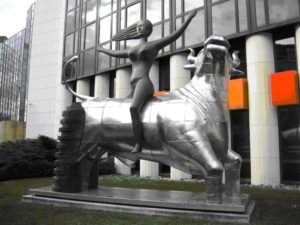 The sculpture, entitled “The Removal of Europa,” was a gift from Crete to the European Parliament in 2005. According to Greek mythology, the Phoenician princess Europa, daughter of the king Agenor of Tyr (now Lebanon), was taken to Crete by Zeus, who was in the guise of a white bull. This work was created by the Greek brothers Nikos and Pantelis Sotiriadis. It weighs almost 6 tons and combines three materials: steel (the bull), bronze (the girl), and glass (the back of the bull).
The sculpture, entitled “The Removal of Europa,” was a gift from Crete to the European Parliament in 2005. According to Greek mythology, the Phoenician princess Europa, daughter of the king Agenor of Tyr (now Lebanon), was taken to Crete by Zeus, who was in the guise of a white bull. This work was created by the Greek brothers Nikos and Pantelis Sotiriadis. It weighs almost 6 tons and combines three materials: steel (the bull), bronze (the girl), and glass (the back of the bull).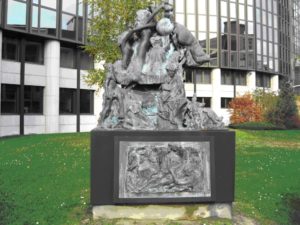 You can also discover the sculpture “Wind from Europe,” by Gianni Visentin, which was a gift from Italy in 1995. It is a hymn to life. The new wind shows the way to overcome materialism and the divisions of the old continent. You can observe a naked family, a symbol of liberty from natural, moral and social pollution, holding up a child out of the poisonous atmosphere, the triumph of the values of solidarity and unity.
You can also discover the sculpture “Wind from Europe,” by Gianni Visentin, which was a gift from Italy in 1995. It is a hymn to life. The new wind shows the way to overcome materialism and the divisions of the old continent. You can observe a naked family, a symbol of liberty from natural, moral and social pollution, holding up a child out of the poisonous atmosphere, the triumph of the values of solidarity and unity.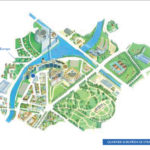
 On this same avenue, before the entrance of the Winston Churchill building, is found a basalt sculpture by the Italian artist Renzo Fioco (Fioco Marco), dated 2000 and named “Europa Unita.” On the pedestal one can distinguish a globe on which is engraved the map of Europe and a handshake, all surrounded by a chain. Also on the pedestal, you can read the inscription “Europa unita,” as well as “Opera di Renzo Fioco da Bagnoregio (VT) A.D. 2000.”
On this same avenue, before the entrance of the Winston Churchill building, is found a basalt sculpture by the Italian artist Renzo Fioco (Fioco Marco), dated 2000 and named “Europa Unita.” On the pedestal one can distinguish a globe on which is engraved the map of Europe and a handshake, all surrounded by a chain. Also on the pedestal, you can read the inscription “Europa unita,” as well as “Opera di Renzo Fioco da Bagnoregio (VT) A.D. 2000.” Another gift from Italy, dated 2003, on the occassion of the Italian presidency of the Council of the European Union, can be found below the old buildings of the European Parliament. It is a sculpture 4 meters high by the artist Pietro Consagra, entitled “Doppia Bifrontale.” Situated next to the Allée Spach press center, this work is in reference to the opera of the same name and by the same artist, inaugurated on July 2, 2003 at the European Parliament.
Another gift from Italy, dated 2003, on the occassion of the Italian presidency of the Council of the European Union, can be found below the old buildings of the European Parliament. It is a sculpture 4 meters high by the artist Pietro Consagra, entitled “Doppia Bifrontale.” Situated next to the Allée Spach press center, this work is in reference to the opera of the same name and by the same artist, inaugurated on July 2, 2003 at the European Parliament.
Learn more about the art collection of the Council of Europe
Your e-mail address is only used to send you our newsletter and information about the activities of Strasbourg Europe. You can always use the unsubscribe link included in the newsletter.
Information Center
on the European Institutions (CIIE)
Europe Direct Information Center
All rights reserved to the CIIE
Non-profit organization
Mailing address
1 allée Kastner
67000 Strasbourg
France
Visitors entrance
8 rue Boecklin
67000 Strasbourg
France
To provide the best experiences, we use technologies such as cookies to store and/or access device information. Consenting to these technologies will allow us to process data such as browsing behavior or unique IDs on this site. Failure to consent or withdrawing consent may adversely affect certain features and functions.
Europe Direct network
The CIIE team
Contact information and opening hours
Lieu d’Europe
The CIIE offices
Internships at the CIIE
Contact us
CIIE’s Documentation Centre & Publications
School presentations & Activities
Borrowing educational kits
Activities for the general public
Eurorépertoire
CIIE’s annual reports
Institutions of the European Union in Strasbourg
Institutions Under the Authority of the Council of Europe
Other European Organisations in Strasbourg
Sessions of the European institutions in Strasbourg
Visiting the institutions
Map of the European district of Strasbourg
Institutions in Strasbourg in photos
Discover artistic Europe
National holidays of the member states of the Council of Europe